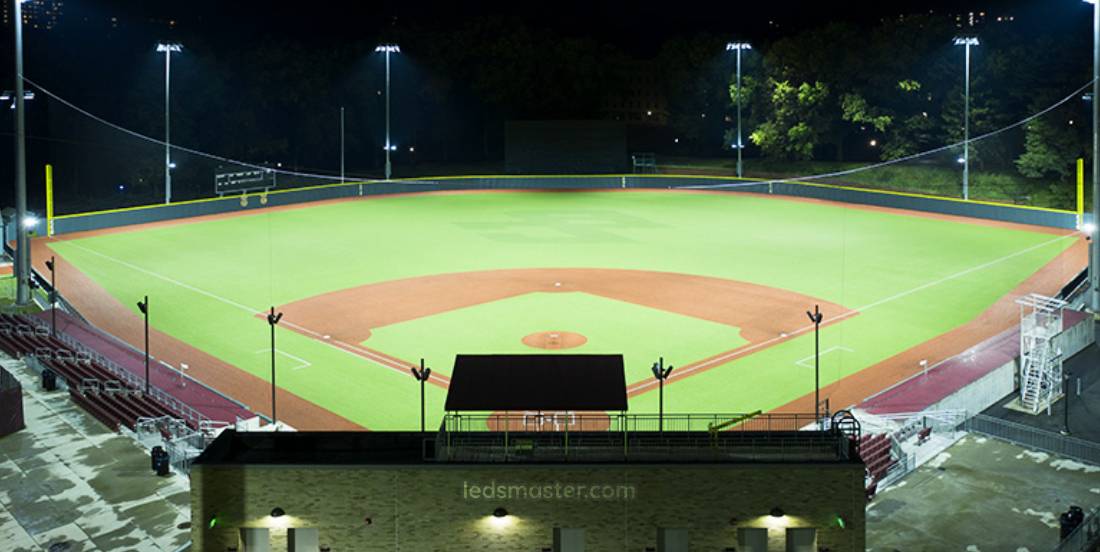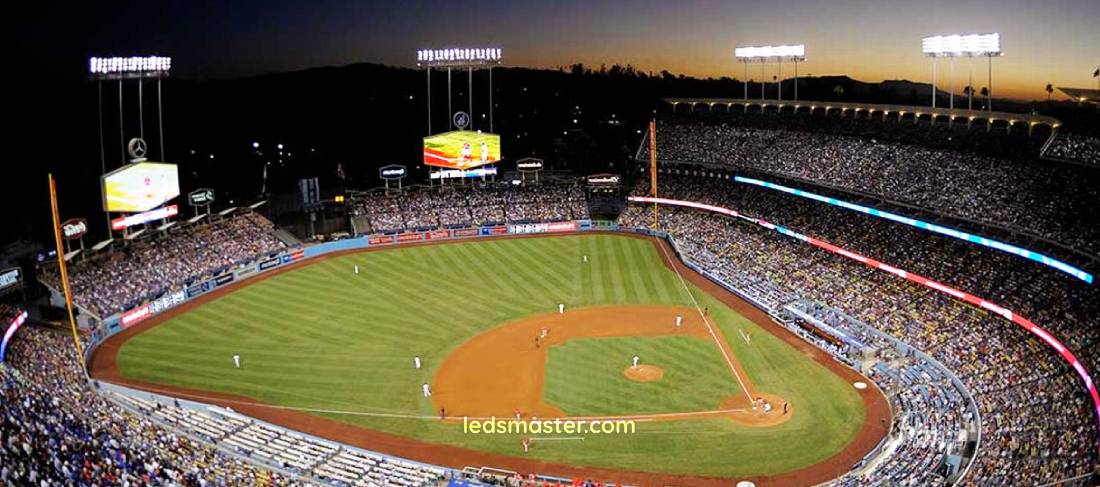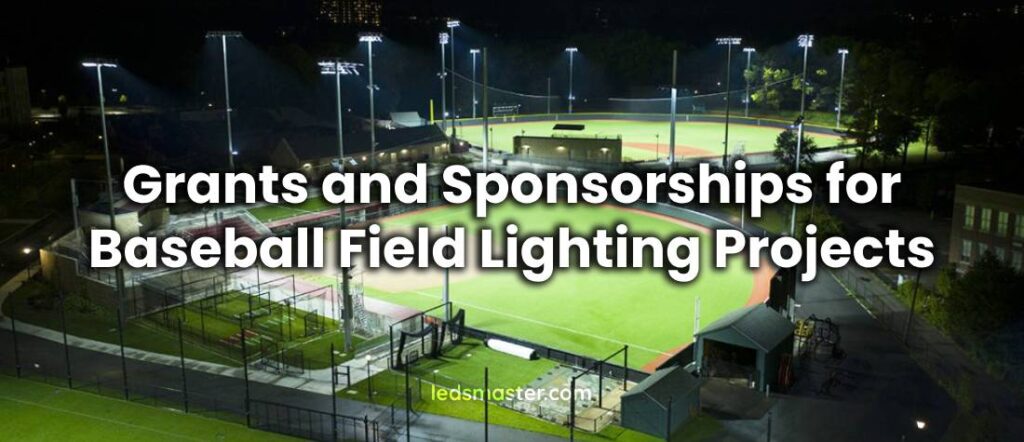Upgrading the lighting of a baseball field can be a valuable investment for any community, school, or sports organization. Modern lighting systems not only improve visibility for players and fans, but they also allow for extended game hours and increased field usage. However, the upfront cost of installing high-quality lighting can be a financial hurdle for many. In such cases, grants and sponsorships offer valuable avenues for securing the funds needed to make these upgrades.
Table of Contents
ToggleUnderstanding Grants for Baseball Field Lighting Projects

Grants are financial awards provided by various government entities, foundations, and organizations to support community projects, including improvements to sports facilities. These funds do not require repayment, making them an attractive option for schools, municipalities, and nonprofit organizations. Obtaining a grant for baseball field lighting involves a competitive application process that often requires a detailed proposal outlining the project and its benefits to the community.
Upgrading baseball field lighting systems is often a costly endeavor, but there are numerous grant opportunities available from federal, state, and local governments, as well as private foundations and organizations. These grants can provide critical financial assistance for the installation of modern lighting systems, especially for community-based organizations, schools, and municipalities. Understanding the types of grants available and the eligibility criteria for each can help increase the likelihood of receiving funding for these improvements.
| Grant Program | Administered By | Annual Funding (approx.) | Eligible Projects |
|---|---|---|---|
| Land and Water Conservation Fund (LWCF) | U.S. Department of the Interior | $122 million (2023) | Public recreational spaces, including lighting upgrades |
| Energy Efficiency and Conservation Block Grant (EECBG) | U.S. Department of Energy | $45 million (2022) | Energy-efficient projects, including LED lighting |
| Proposition 68 (California) | California State Government | $50 million (2020) | Park improvements, including field lighting |
| Robert Wood Johnson Foundation | Robert Wood Johnson Foundation | Varies annually | Public health and community development projects |
| Wells Fargo Foundation | Wells Fargo Foundation | $81 million (2021) | Youth engagement, public recreation improvements |
| Kresge Foundation | Kresge Foundation | $10 million (2020) | Urban revitalization and public health projects |
Government Grants for Sports Facility Lighting

One of the largest sources of funding for public sports infrastructure projects comes from government grants. Various federal and state programs are designed to support recreational development, improve public spaces, and promote sustainability, and these funds can often be applied to projects involving baseball field lighting. Some key grant programs include:
Federal Grants
The U.S. Department of the Interior’s Land and Water Conservation Fund (LWCF) is one of the most notable federal programs available to municipalities and state governments. The LWCF is designed to support the development of public recreation spaces, such as parks, playgrounds, and sports fields, across the country. Grants from the LWCF can be used to fund a wide range of projects, including field renovations and the installation of lighting systems.
In 2023, the Land and Water Conservation Fund allocated $122 million to state and local governments for the improvement of public recreational spaces. These funds could be used for sports field lighting, provided that the project improves public access to recreational areas. The fund supports projects that meet specific environmental and recreational goals, and communities must demonstrate how their proposed upgrades will benefit public use.
Another important federal grant source is the Energy Efficiency and Conservation Block Grant (EECBG), which is administered by the U.S. Department of Energy. The EECBG program aims to support energy-saving projects at the local government level. As baseball field lighting often accounts for significant energy consumption, this program can help fund the transition to energy-efficient systems like LED lighting, which offer long-term cost savings. In 2022, the EECBG allocated $45 million in grants to cities, counties, and tribal governments for energy-efficiency projects, including lighting upgrades.
State and Local Government Grants
In addition to federal funding, many state and local governments offer grants for the development and improvement of public recreational spaces. These grants often focus on specific areas such as parks and recreation, sports facilities, and energy efficiency. Each state has its own set of programs, which can be tailored to the needs of the local community. For example, California’s Proposition 68 offers funding for recreational improvements that include sports field lighting upgrades, with a focus on accessibility and environmental impact. In 2020, California allocated $50 million in funding for parks and recreation grants under this program.
State governments may also offer grants aimed at reducing environmental impact and promoting sustainability. For example, Texas Parks and Wildlife provides grants through its Outdoor Recreation Grants Program, which can be used to fund field lighting projects that incorporate energy-efficient technologies.
Private Foundation Grants
In addition to government sources, several private foundations and nonprofit organizations offer grants for sports facility improvements, including lighting. These organizations typically focus on promoting youth engagement, community development, and health and wellness. Many of these foundations are more flexible than government programs in terms of their funding priorities, making them an attractive option for community organizations seeking financial support for baseball field lighting.
The Robert Wood Johnson Foundation
The Robert Wood Johnson Foundation (RWJF) is one of the largest philanthropic organizations in the U.S. focused on public health. RWJF supports initiatives that promote healthy communities, including access to recreational spaces. While RWJF does not offer grants exclusively for sports field lighting, it frequently funds projects that focus on improving the quality of life in underserved communities, which may include lighting upgrades for public fields.
In 2022, the RWJF awarded $28 million in grants to local communities to support various public health and community development projects. Communities interested in field lighting upgrades can apply for funding through RWJF’s Healthy Communities program, which focuses on projects that help people live healthier lives through improved access to safe public spaces.
Wells Fargo Foundation
The Wells Fargo Foundation is another major philanthropic organization that offers grants to support community development and infrastructure projects. The foundation has a long history of supporting public parks, recreational spaces, and youth sports programs. Baseball field lighting projects that serve local youth leagues or provide access to safe recreational spaces in underserved areas are eligible for funding under Wells Fargo’s Community Giving Program. The Wells Fargo Foundation typically allocates millions of dollars each year to support community development, education, and housing projects.
In 2021, the Wells Fargo Foundation distributed $81 million in grants to local community organizations and nonprofits. These grants often focus on improving access to recreational and educational opportunities, and baseball field lighting is an integral part of that mission. Communities seeking funding for lighting upgrades should ensure that their projects align with the foundation’s goals for community empowerment and engagement.
The Kresge Foundation
The Kresge Foundation, based in Michigan, is another private foundation that funds projects aimed at improving community infrastructure. It supports both large and small projects that focus on urban revitalization, youth engagement, and health and wellness. The foundation’s Healthy People and Places program can be a potential funding source for baseball field lighting upgrades, particularly those that focus on enhancing public recreation areas for underserved populations.
In 2020, the Kresge Foundation granted over $10 million to support health-focused urban development projects. Field lighting projects that can demonstrate benefits in terms of community health, safety, and engagement may be well-suited for Kresge funding.
How to Apply for Baseball Field Lighting Grants
Applying for a grant to fund baseball field lighting requires careful planning and a well-prepared proposal. First, it’s important to identify the right funding sources that align with the goals of the project. This involves researching various grant programs and reviewing eligibility criteria. Once the appropriate grants have been identified, the next step is to create a detailed proposal that outlines the project’s objectives, expected costs, and the benefits to the community.
The proposal should include a comprehensive budget, a timeline for completion, and any necessary supporting documents, such as letters of support from community leaders. It is essential to demonstrate how the lighting project will enhance public safety, increase recreational opportunities, or contribute to sustainability. The more detailed and well-organized the proposal, the better the chances of receiving funding. After submission, it is important to follow up with the funding organization to ensure that the application has been received and is being reviewed.
Corporate Sponsorships for Baseball Field Lighting Projects
Sponsorships from local businesses and large corporations can also provide the necessary funding for baseball field lighting projects. Sponsorship arrangements are typically a win-win situation for both the sponsoring business and the sports organization. Businesses gain visibility and positive community recognition, while sports facilities benefit from the funding needed to enhance their infrastructure.
The Role of Local Businesses in Sponsoring Lighting Projects
Local businesses are often among the most willing to support community initiatives, especially when they see a direct benefit to their brand and reputation. Businesses that are located near the baseball field or have a vested interest in supporting youth sports are prime candidates for sponsorship. By sponsoring the lighting upgrade, these businesses can receive various forms of recognition, such as having their name featured on signage at the field, in game programs, or on social media.
When approaching local businesses for sponsorship, it is important to present a compelling case for the project’s value to the community. Emphasizing the role of the lighting project in supporting local youth sports leagues, improving safety for players and spectators, and expanding opportunities for community events can make the project more appealing. Additionally, offering tiered sponsorship packages allows businesses to choose a level of involvement that suits their budget and marketing goals.
Approaching Large Corporations for Sponsorship Opportunities
While local businesses are important sponsors, larger corporations may also be willing to provide funding for sports infrastructure projects, especially if they align with the corporation’s community engagement goals or environmental initiatives. Corporations involved in the energy, sports, or technology sectors, for example, may be particularly interested in sponsoring lighting upgrades, particularly if the project involves energy-efficient systems.
When seeking corporate sponsorship, it is essential to present a well-structured proposal that outlines the benefits to the company. For example, a corporate sponsor may be interested in promoting their commitment to sustainability if the lighting project includes the installation of energy-efficient LED lights. Similarly, companies with a strong focus on youth or sports development might see sponsoring a baseball field lighting project as an opportunity to strengthen their brand’s association with healthy, active communities.
Larger corporations may also be open to sponsorship if the project includes the possibility of naming rights. For instance, a corporation might sponsor a field’s lighting system in exchange for the naming rights to the field or specific components of the lighting infrastructure. These types of sponsorship deals can generate substantial funding for the project, while providing the corporation with a prominent, long-term marketing opportunity.
The Benefits of Sponsorship for Baseball Field Lighting Projects
Sponsorships offer several advantages over traditional grant funding. First, they can often provide more flexibility in terms of funding amounts and usage, as corporate sponsors may be willing to contribute a larger share of the project’s cost. Furthermore, sponsorships can provide additional benefits, such as ongoing partnerships that include future financial support or promotional opportunities.
For sports organizations, securing sponsorship for lighting upgrades can also foster deeper connections with the local business community. These partnerships often lead to additional opportunities for collaboration, such as organizing events or programs that benefit both the field and the sponsors. Sponsorships can also generate community goodwill, as local businesses gain recognition for supporting a community initiative that has a positive impact on youth sports and recreation.
Combining Grants and Sponsorships for a Successful Project
In many cases, combining grants and sponsorships is the most effective approach to funding a baseball field lighting project. By securing multiple funding sources, sports organizations can reduce the financial burden of the project while increasing the chances of receiving the necessary support.
When combining grants and sponsorships, it is important to ensure that the contributions from each source complement one another. For example, grant funding may cover the bulk of the lighting system’s installation costs, while sponsorships can help cover ongoing maintenance or energy costs. In some cases, businesses may be more willing to provide sponsorship funds if they see that other sources, such as grants, have already committed to the project.
A strategic approach to combining these funding sources involves developing a clear budget and identifying which expenses can be covered by grants and which can be offset by sponsorships. It is also helpful to establish a timeline for the project that includes key milestones, such as receiving grant approvals and securing sponsorship commitments. Having a clear plan for how the funding will be used can help instill confidence in both grant-making organizations and potential sponsors.
Community Support and Fundraising
While grants and sponsorships are often the primary sources of funding for baseball field lighting, community support and fundraising efforts can play an important role in closing the gap. Hosting fundraising events, such as charity games, auctions, or raffles, can generate additional funds for the project while engaging the community in the effort.
Community-driven fundraising campaigns can also help raise awareness of the project and encourage local residents to get involved. In some cases, smaller contributions from a large number of community members can add up to a significant amount of funding. Additionally, these efforts can help build a sense of ownership and pride in the project, as local residents and businesses see the impact of their contributions.
Final Thoughts on Securing Funding for Baseball Field Lighting
Securing funding for a baseball field lighting project requires a multi-faceted approach that includes researching available grants, seeking sponsorships from local businesses and corporations, and engaging the community in fundraising efforts. By exploring a variety of funding avenues and presenting a compelling case for the project, sports organizations can increase their chances of success. With the right mix of financial support, upgrading baseball field lighting becomes a viable and valuable investment that benefits players, fans, and the community as a whole.

